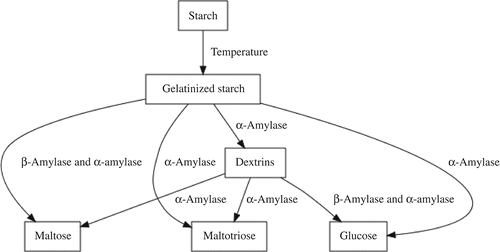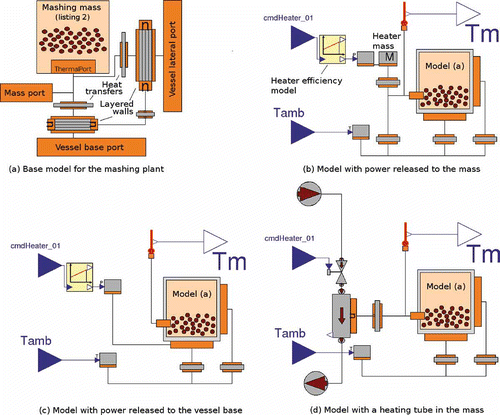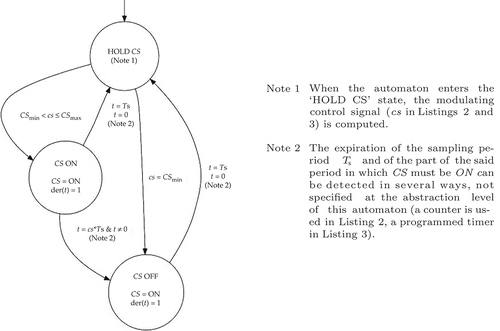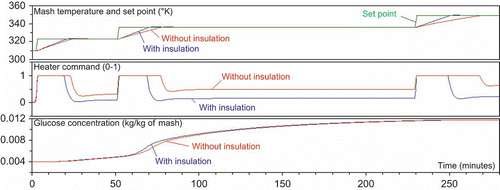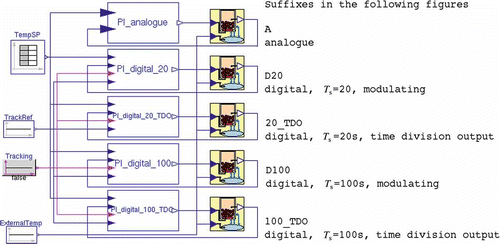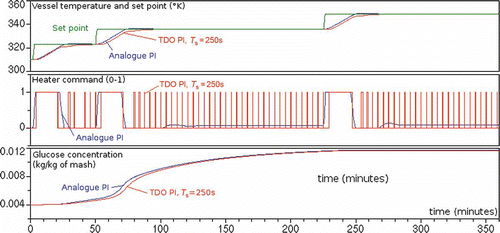Abstract
In the production of beer, good temperature control of the starch mashing phase is very important for both the final product quality and the process efficiency. A precise tuning of the said control is, however, complicated by the highly non-linear nature of the process, and often also by the actuation scheme. Based on suitably extended literature models, this article shows how object-oriented modelling and simulation (OOMS) can be used to devise a solution to the above problem. A mashing model is first derived along the OOMS approach, and then the said model is coupled to a control representation of scalable detail, including a quasi replica of the control code. Doing so allows one to easily create and maintain hybrid overall models that are suitable for system studies on the design and assessment of both the control strategy and the process instrumentation, with particular reference to the use of on–off actuation in conjunction with modulating control.
1. Introduction
The most important parts in the brewing process are the starch mashing and the fermentation phases, although this work concentrates on the first one due to space limitations. During starch mashing, good temperature control is crucial for final product quality [Citation1,Citation2]. As such, many mashing models have been proposed in the literature, see, for example, [Citation3,Citation4], but basically with the purpose of understanding the underlying biochemistry, thereby correctly sizing the process components from a static point of view. For the reasons briefly discussed in the following, said models are conversely unfit for simulation-based control studies aiming at achieving dynamic performance (and in the future also for model-predictive schemes).
The contribution of this article, which joins and completes the preliminary results of Refs. [Citation5,Citation6], can be summarized as follows. The mashing model mentioned in the literature is extended to make it suitable for system simulation studies aimed basically at temperature control, and then implemented in a modular way by exploiting the object orientation of the Modelica language [Citation7]. Thanks to the adopted approach, the obtained model is coupled to scalable-detail representations of the heating system and the control blocks. This allows to simulate the synthesized control systems both as continuous-time models and by replicating the digital (both time- and event-driven) controllers. It is, therefore, possible to point out which aspects of the detailed controller implementation may have some impact on the achieved performance and also to assess the suitability of possible low-end, hence low-cost, actuating solutions (e.g. an on-off heater vs. a modulating one). In synthesis, a realistic example is provided here of how object-oriented modelling methodologies can describe both a physical plant and its digital control in a unitary manner, thereby effectively supporting their co-design and co-assessment by providing modular and well-manageable simulators. Some examples relative to a system study with different plant and control configurations demonstrate the usefulness of the presented (hybrid) models, and therefore of the underlying approach.
2. The plant model
2.1. Mashing mass
This work starts from the well-assessed mashing model proposed in Ref. [Citation3]. The core of that model is the estimation (based on first-principle equations and well-grounded correlations) of the starch hydrolysis rate, which determines the quantity of fermentable carbohydrates in the wort, and therefore the alcoholic content of the beer. The objective is to reach the maximum possible fermentable carbohydrates productivity, subject to a convenient (and frequently product-specific) specification on the final dextrins (i.e. non-fermentable carbohydrates) concentration, as dextrins influence the organoleptic qualities of the beer. The starch is first gelatinized, and then transformed into fermentable sugars (sucrose, maltose and maltotriose) and non-fermentable sugars (dextrins) through the enzymatic activity. Of course, gelatinization is not an instantaneous activity, as it depends on the concentration of the involved reactants and on temperature.
If temperature is taken as exogenous like in Ref. [Citation3], the only model dynamics comes from mass balances (or, equivalently, concentration balances, since mashing is carried out in fixed-volume batches). In such a framework, the starch gelatinization kinetic is represented as a first-order reaction. From extensive experiments documented in the literature (see, e.g. the bibliography of the quoted work), it can be concluded that gelatinization exhibits a remarkable discontinuity at a temperature T g, typically around 60°C. The starch gelatinization rate r g, expressed in g/kg s, is thus traditionally modelled by two alternative equations, namely,
According to the Scheme (4) and taking into account the action of α- and β-amylases, the kinetics for the gelatinized starch hydrolysis (expressed in g/kg s) into glucose, maltose, maltotriose and dextrins are, respectively,
Although a model with exogenous temperature is suited for biochemical studies, it is apparently unfit for the system studies, particularly related to control. To represent temperature dynamics in a suitable way for such studies, the model must necessarily include energy balance equations. Said equations in turn have to account for the thermal energy storages in the starch mass and the containing vessel, the reaction heat rates, the heat released by the control actuator to the vessel wall to control temperature (in normal conditions heating is needed), and the unavoidable losses toward the external environment. It is therefore advantageous to exploit the object-oriented approach by partitioning the overall model into a ‘mashing mass’ and a ‘containing vessel’ component, and defining suitable a-causal connectors to allow the same components to represent the various situations to be considered.
To maintain complexity to an acceptable level for system studies, some assumptions are introduced: the wort is perfectly mixed, with spatially homogeneous temperature and concentrations, the specific heat and density of all the components are constant in the considered temperature range and (of course) the heat contribution of the mechanical mixing action is negligible. The net power entering in the mashing mass (in W) is
Briefly, only the equations for the power originating from the glucose production are shown here; those related to maltose and maltotriose are analogous. The power generated by a reaction is typically in the form
For the Modelica implementation of the model, an a-causal thermal connector (an object in the overall final model) is first defined, following the Modelica standard practice, as
The main part of the model, omitting constants and variables' declarations for brevity, is reported as Listing 2 (all the Modelica models used here can be obtained by contacting the corresponding author).
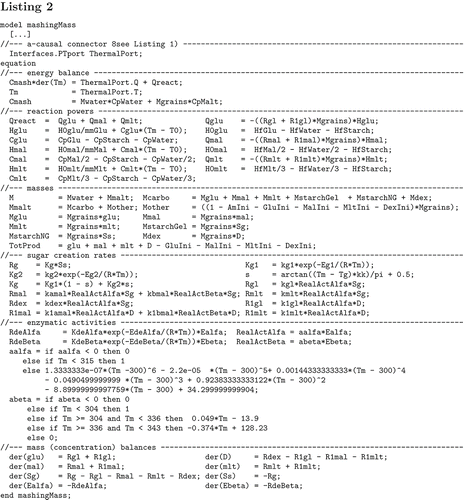
2.2. Vessel and heating system
Various Modelica models were created to represent the containing vessel and the heating system. Details are omitted due to space limitations, suffice to say that said models include layered metal walls (obtained by spatially discretizing the Fourier equation) connected with connectors analogous to that of Listing 1 where temperatures and powers are vectors of suitable sizes, exchange elements with two thermal ports and a static relationship between power flow and temperature difference (so as to account for both convection and radiation), concentrated metal masses for single-temperature energy storages, exchanging tubes described by a finite-volume approach and so on (the ThermoPower library [Citation8] was used as a reference).
As a result, different models of the mashing plant can be created easily, both with different heating systems and with different boundary conditions. It is possible, for example, to impress the mash temperature by simply connecting a fixed temperature source to the mass model, therefore inverting the said model and determining the power required to attain a given temperature profile.
Some examples of the models that can be obtained are shown in , to evidence the flexibility of the adopted object-oriented modular approach, and the ease in obtaining different models of the mash/vessel/heating compound, with various topologies and detail levels, with a significant code reuse. All the presented models share the causal input and outputs that with the heating tube also having of course two flanges for the heating fluid. The models were successfully validated versus their literature counterpart [Citation3]; the validation tests (actually for a simpler model than those shown here, but conceptually equivalent) are described in Ref. [Citation6] and omitted here for brevity.
3. Temperature control
Temperature control plays a decisive role on the decomposition of malts and is, therefore, crucial for beer qualities such as stability and taste. The saccharification temperature control should track the required set point curve (pre-specified based on the ingredients and the desired product characteristics, so that it can be thought of as a recipe datum) quickly, accurately and without overshoots during the temperature rise; the same control should also exhibit good load disturbance rejection properties, to rapidly lead the temperature back to the set point should the system exhibit any error caused by external disturbances.
A relevant fact in the mashing temperature control is that heating actuators are typically operated on–off because it would be impractical to modulate them, and very frequently their efficiency degrades if they are not used at the nominal power operating point (where the design was optimized). To account for that without complicating the model excessively, an extremely simplified actuator model is thus introduced, composed of a variable efficiency and a first-order lag accounting for internal thermal inertia. It is, therefore, assumed that the heater is governed by
To use modulating control with on–off actuation, probably the most employed technique is the so-called ‘Time Division Output’ (TDO) [Citation9], where the control signal is interpreted as the duty cycle of a square wave with period equal to the modulating controller's sampling time; said square wave in turn provides the activation signal for the on–off actuator. Apparently, if the sampling time is correctly chosen, the TDO scheme can successfully emulate a fully modulating one.
However, with TDO, the choice of the sampling time has additional effects with respect to those well known in modulating digital control. In fact, a longer sampling time results in less actuator wear, and this is quite immediate. Moreover, different sampling times will produce different behaviours of the system variables, and therefore the advantage of having the actuator either off or operating in its maximum efficiency point can be enhanced or diminished; apparently, this second phenomenon is impossible to characterize in closed form, so that resorting to accurate simulation is mandatory.
Specifying hybrid systems (like those formed from a continuous-time process model and an event-based controller as the one addressed here) in a formal way is a subject that has been devoted long-lasting research, starting from pioneering works such as in Ref. [Citation10] and now comprising both methodological studies (see, for example, Ref. [Citation11]), more implementation-oriented works [Citation12,Citation13], and a number of applications in various domains, like those in Refs. [Citation14,Citation15]. What is peculiar here is the inclusion of a quasi replica control code representation in an object-oriented framework.
For the purpose of our research, a PID controller in the ISA form [Citation9,Citation16] with TDO was then realized in Modelica, using the language when-clause to describe the event-based part (sampling and output switching). Such a PID is described by the hybrid automaton [Citation17] of (the reader who needs information on the hybrid automaton formalism can find complete information in the quoted reference).
In , T s stands for the controller sampling time, cs for the modulating control signal (bounded to be within a minimum and a maximum value, CS min and CS max), CS is the (time division) controller output, which can be ON or OFF, and t is the (continuous) time.
Note, however, that the system in is not totally unambiguous in its realization, in that there is no representation of the time thresholding that can be directly turned into an algorithm (see the notes in the figure). For example, one can detect the expiration of the output switching time by means of a counter preset with a specified resolution, which leads to the Modelica code as shown below in Listing 3. The presented code reproduces the regulator tracking mechanism to further show the achievable realism; that mechanism is not strictly relevant for the studies presented here, however, and is therefore included only for completeness.
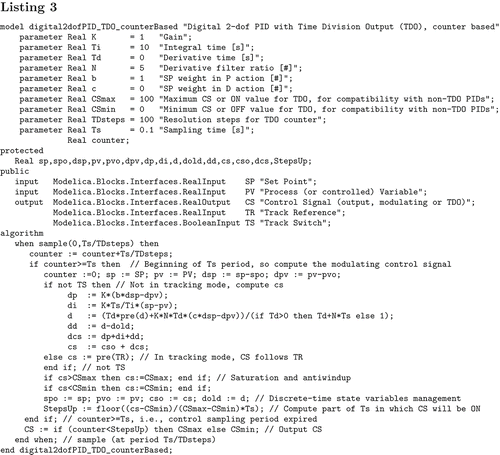
An alternative representation of the same PID can be achieved in Modelica without the use of the counter variable of Listing 2 above, and would correspond in the physical reality to a device using a programmable timer, instead of a counter, to trigger the TDO switching; the said alternative PID is shown below (partly, for brevity) in Listing 4.
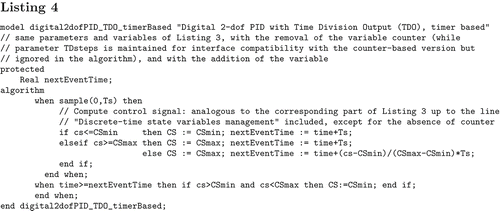
Note that the interfaces of both the above PID models are totally identical to that of their analogue and digital counterparts with modulating outputs, allowing for the comparative simulations reported later on.
4. Three simulation studies
4.1. Different heating mechanisms
The first study reported here concerns the effect of a thermal insulation applied to the vessel in the hypothesis where the heat is released to the mash, that is, based on model (b) in . To enhance the significance of the study, the scheme is applied to a definitely small vessel, compatible with a ‘home brewing’ case (the mashing mass is about 40 kg); this makes the overall system more reactive than the typical industrial case, thus allowing the facts of interest to emerge more clearly (of course, the results are valid for any vessel size).
As can be seen from , the said insulation (obviously) reduces the required heating power with practically no detriment of the product; the study was very simple to carry out with the models of and a standard modulating PI controller.
4.2. Temperature control with different actuation schemes
To show in particular the usefulness of having in the presented model a continuous-time process plus a quasi-replica digital control and different actuation schemes, a second simulation study is presented where a temperature controller is designed, and then its performance is assessed with both modulating and TDO actuation. In this case, heat is released to the vessel, that is, model (c) in is used. Given the scope of this work, the considered scheme is here too a PI-based one, with the same small vessel as the previous case.
First, the PI regulator was tuned by simulating a step response, identifying a first-order model plus dead time with the method of areas [Citation9], and then applying the IMC-PI tuning rules [Citation16,Citation18,Citation19]. Details on this (standard design) are omitted for brevity, suffice to say that the result is a PI controller with a gain of 0.4 and an integral time of 340 seconds. Then, the so-obtained control was implemented in Modelica as shown in , that is, as a completely analogue system and as a hybrid one (continuous-time process plus digital controller) with both a modulating and a TDO actuator, and with different sampling times (20 and 100 seconds).
reports the simulation results. As can be seen the controlled variable's behaviour is practically the same in all the five cases, although this is not true for the control signals (even for the modulating version of them in the TDO cases). This is basically due to the different antiwindup implementation in the analogue and digital PIs, and also to the interplay between the process dynamics and the on–off actuation with TDO, shown as an example in . Both phenomena are virtually impossible to analyse without simulation, although they emerge very clearly in the presented tests. Also the product characteristics can be evaluated in all the cases using the dextrins concentration as a metric for goodness, as depicted in .
Figure 6. Simulation Study 2 – set point and controlled variable (mashing mass temperature), left, and control signals (right).

As a result, the tests (made possible by the co-existence of a detailed continuous-time process model and a scalable-complexity control representation) allow us to conclude that a TDO with a period of 100 seconds can be used safely, in the fulfilment of the same requirements achieved with the analogue control.
As a further remark, notice the energy consumption curves of that allow to quantify the energy savings yielded by TDO actuation, where the heater is either off or used in its optimal (design) operating point. The simulation model presented here allows for conclusions on that important matter also and confirms that the TDO scheme is more or less equally advantageous for both the sampling periods adopted, even with a simplistic actuator model as in EquationEquation (17)(17). It is then possible to use the longer one to the advantage of actuator lifetime because less switching is involved – another fact for which intuition would not have been of help without detailed simulation.
Finally, it is informative to compare the simulation performance of the counter-based PID (used up to now, with a granularity of N s = 100 possible switching instants, expressed by parameter TDsteps in Listing 2, within the sampling period T s) and the timer-based PID of Listing 3, which does not constrain the integration to be stopped every T s/N s time units. Just to give a figure, a simulation duration of 16,800 seconds requires 34,568 integration points and about 6.3 seconds of CPU time on a dual-core processor at 2.4 GHz, whereas 1914 points and 0.48 seconds are enough with the timer-based (i.e. fully event-based) version of the PID. Of course, the results differ a bit but not to a control-relevant extent, and the timer-based PID allows to approach the (best achievable) speed obtained with a completely analogue system and modulating output, which requires 1041 points and 0.07 seconds. Notice that the analogue system is much faster because only equations (and no digital algorithms) are present, which eases the model manipulation by the Modelica translator. However, the number of result points needed with the fully event-based control representation is comparable to that of the analogue case, which is not true (and by an order of magnitude) if the counter-based one is used.
It therefore appears that with the proposed approach it is possible to emulate with great fidelity the hardware functioning if this is required, or – on the contrary – to choose the most efficient way of representing event-based systems if not so much detail in the control program timing emulation is necessary.
4.3. An industrial scale vessel
This section briefly reports a final example in which an industrial scale vessel, containing 500 L of mash and with 30 kW of maximum heating power, is considered. The temperature is here too controlled by a PI regulator tuned empirically by means of a simulated step response record, yielding a gain of 0.7 and an integral time of 600 seconds. The heating actuation scheme is the same as in the Simulation Study 2. By conducting tests as in the previous examples, it is here concluded that TDO can be used with a period of 250 seconds. In other words, simulation allows to quantitatively evaluate the possibility of a longer actuation period provided by the larger system inertia with respect to the small vessel considered before. compares the TDO actuation scheme with a modulating one, demonstrating that the results in terms of the relevant variables (only the glucose concentration is shown for brevity) are definitely acceptable. This particular study then confirms the capability of the presented model (including both the continuous-time process and the possibly hybrid regulator, it is worth recalling) to also replicate industrial scale cases, yielding realistic and useful results.
5. Conclusions and future work
A well-assessed literature model of the starch mashing phase in the brewing process was complemented with suitable energy balance equations, so as to make it suitable for the design and the simulation-based assessment of the necessary controls. The said model was implemented exploiting the modularity and object-orientation of the Modelica language. Some heating and temperature control schemes were then presented, containing both continuous-time and digital versions of the controller, and also dealing with on–off actuation based on the TDO principle.
The presented results show that the devised models (and more in general the underlying methodologies) are suitable for control studies of scalable detail, allowing for effective modularity and code reuse. It is worth noting that models here can include a quasi replica control representation, thereby extending model-based studies to the control system up to a level of detail that is extremely close to the final implementation on the plant instrumentation. In those studies the overall system can be simulated as a continuous-time one (to set up a control strategy and assess its suitability to the problem at hand), and also as a hybrid one including both time- and event-based controllers (allowing for a detailed sizing and verification of the corresponding algorithm and equipment). The use of the object-oriented approach to modelling and simulation allows the designer to seamlessly select the best detail level for the particular simulation needed, hence being a key factor in the achievement of the presented results.
Future developments will include more extensive use of model-based control techniques, further validations of both the model and the control schemes developed with them, more precise description of actuators and their efficiency along the mentioned object-oriented reasoning and the integration of model forecasts and process measurements, to further improve (also online) the control results.
References
- Alvarez , E. , Correa , J.M. , Navaza , J.M. and Rivero , C. 2000 . Injection of steam into the mashing process as alternative method for the temperature control and low-cost of production . J. Food Eng. , 43 ( 4 ) : 193 – 196 .
- Jiliang , S. , Wei , Y. and Dexin , G. Study of compound optimal control for beer saccharification temperature . Proceedings of the 26th Chinese Control Conference . Zhangjiajie, PR China. pp. 356 – 359 .
- Brandam , C. , Meyer , X.M. , Proth , J. , Strehaiano , P. and Pingaud , H. 2003 . An original kinetic model for the enzymatic hydrolysis of starch during mashing . Biochem. Eng. J. , 13 ( 1 ) : 43 – 52 .
- Koljonen , T. , Hämäläinena , J.J. , Sjöholmb , K. and Pietiläb , K. 1995 . A model for the prediction of fermentable sugar concentrations during mashing . J. Food Eng. , 26 ( 3 ) : 329 – 350 .
- Leva , A. and Donida , F. Control system design for the starch mashing phase in the production of beer . Proceedings of the 7th Modelica Conference . Como, Italy.
- Leva , A. , Donida , F. and Bordoni , M. Object-oriented modelling and simulation of starch mashing . Proceedings of the ADHS’09 . Zaragoza, Spain. pp. 80 – 84 .
- The Modelica Association, The Modelica language, 2009. http://www.modelica.org (http://www.modelica.org) (Accessed: 20 July 2010 ).
- Casella , F. and Leva , A. 2006 . Modelling of thermo-hydraulic power generation processes using Modelica . Math. Comp. Model. Dyn. System , 12 ( 1 ) : 19 – 33 .
- Åström , K.J. and ägglund , T. H . 1995 . PID Controllers: Theory, Design and Tuning , Durham, , NC, USA : ISA, Research Triangle Park .
- Mrhailaf , R. and Sahraoui , A. DFD extended methods for specifying hybrid systems . Proceedings of the ICSMC’93 . Le Touquet, France. pp. 681 – 686 .
- Bars , R. , Colaneri , P. , de Souza , C.E. , Dugard , L. , Allgower , F. , Kleimenov , A. and Scherer , C. 2006 . Theory, algorithms and technology in the design of control systems . Annu. Rev. Control , 30 ( 1 ) : 19 – 30 .
- Ferreira , J.A. , Almeida , F.G. , Quintas , M.R. and de Oliveira , J.P.E. 2004 . Hybrid models for hardware-in-the-loop simulation of hydraulic systems – Part 1: theory . Proc. Inst. Mech. Eng. Part I-J. Syst. Control Eng. , 218 ( 16 ) : 465 – 474 .
- Tudoret , S. , Nadjm-Tehrani , S. , Benveniste , A. and Stromberg , J.E. 2000 . “ Co-simulation of hybrid systems: signal-simulink ” . In Formal Techniques in Real-Time and Fault-Tolerant Systems – Lecture Notes in Computer Science , Edited by: Joseph , M. Vol. 1926 , 134 – 151 . Berlin, , Germany : Springer-Verlag .
- Balluchi , A. , Bicchi , A. , Mazzi , E. , Sangiovanni Vincentelli , A. and Serra , G. 2007 . Hybrid modelling and control of the common rail injection system . Int. J. Control , 80 ( 11 ) : 1780 – 1795 .
- Sohlberg , B. 2005 . Hybrid grey box modelling of a pickling process . Control Eng. Practice , 13 ( 9 ) : 1093 – 1102 .
- Leva , A. and Colombo , A.M. 2001 . Implementation of a robust PID autotuner in a control design environment . Trans. Inst. Measurement Control , 23 ( 1 ) : 1 – 20 .
- Lygeros , J. , Johansson , K.H. , Simic , S.N. , Zhang , J. and Sastry , S.S. 2003 . Dynamical properties of hybrid automata . IEEE Trans. Automatic Control , 48 : 2 – 17 .
- Braatz , R.D. 1996 . “ Internal model control ” . In The Control Handbook , Edited by: Levine , S. 215 – 224 . Boca Raton, FL : CRC Press .
- Leva , A. and Colombo , A.M. 2004 . On the IMC-based synthesis of the feedback block of ISA-PID regulators . Trans. Inst. Measurement Control , 26 ( 5 ) : 417 – 440 .
